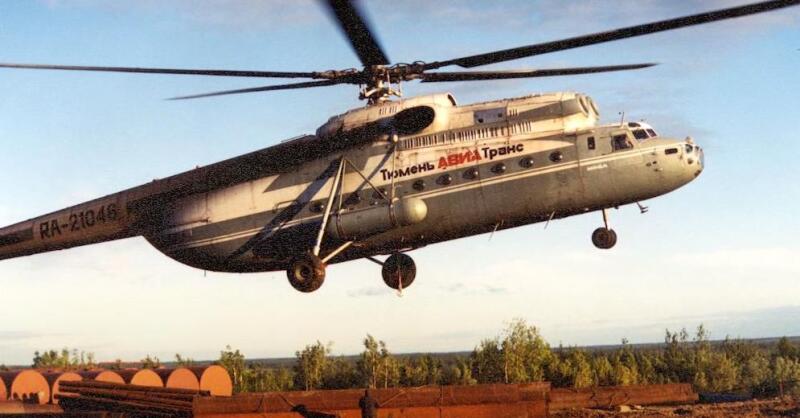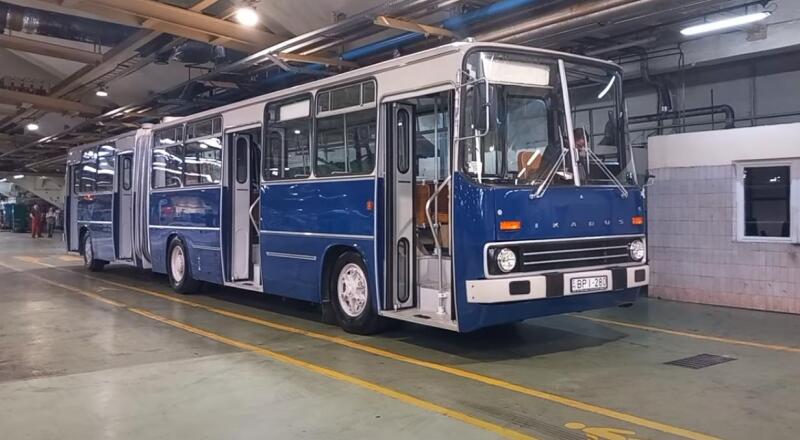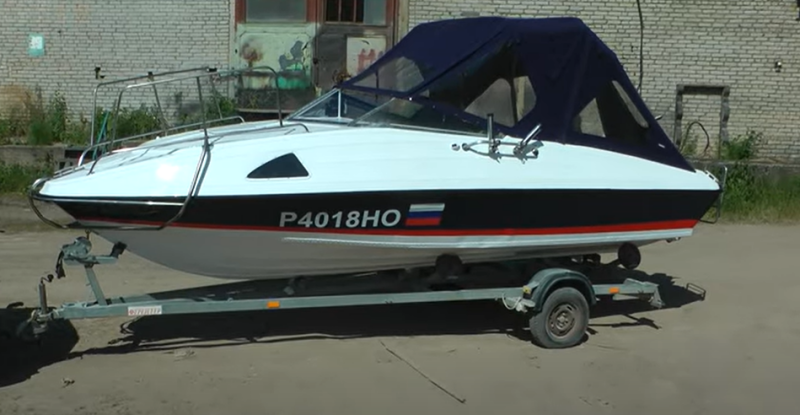Previous attempts by both Soviet and foreign designers to launch a helicopter with a takeoff weight of more than 14 tons were not successful. Mil was advised to abandon the usual screw layout and make it longitudinal. However, the chief designer of the proposal did not accept and preferred to build an aircraft with one main rotor, which had an unprecedented diameter at that time: more than 30 m. Then, for machines of this type, this value did not exceed 25 m.
 The scope of the Mi-6 propellers was impressive. Photo: YouTube.com
The scope of the Mi-6 propellers was impressive. Photo: YouTube.comAn attempt by the American company Hughes to build a helicopter with propellers with a diameter of 37,6 m failed. And the world did not even try to make a special gearbox designed for a heavy machine.
Projects
During the initial development, the Milevsky apparatus received the index VM-6. It immediately became clear: a piston engine would not work, so it was decided to use the Kuznetsov TV-2F gas turbine engine. After being converted into a helicopter, it received the name TV-2VM. For better centering of the body, the motor was installed in front of the main gearbox. At first, one engine was designed, but after the intervention of the military, who demanded an increase in carrying capacity, two had to be delivered.
 Helicopter with wings? Then it was something new! Photo: YouTube.com
Helicopter with wings? Then it was something new! Photo: YouTube.comIn addition, the customer also wanted to get more speed so that the car flew almost like an airplane. Mil also worked on this option with dismantled wings, but subsequently abandoned it.
At the same time, an order for the creation of a heavy machine was transferred to the Kamov Design Bureau, where the Ka-22 model was already being developed. The device had a transverse layout with a pair of rotors and as many pulling ones.
 Kamov made his Ka-22 helicopter. Photo: YouTube.com
Kamov made his Ka-22 helicopter. Photo: YouTube.comThe preliminary draft VM-6 was completed by December 1953. Now they had to perform an equally difficult task: to convince the government that “all this will fly,” and it will fly well. Six months later, in the summer of 1954, the necessary Resolution of the Council of Ministers of the USSR was received, the money was allocated.
 Assembling helicopters at the factory. Photo: YouTube.com
Assembling helicopters at the factory. Photo: YouTube.comThe preliminary design of the B-6 (as they began to call the new helicopter for short) was presented by the end of the same year. The development was approved in the summer of 1955. The construction of prototypes started at two factories: No. 23 and No. 329. Here the helicopter was renamed again, now it has finally become known as the Mi-6. Although the shops and documents featured "product 50".
Development difficulties
First of all, they arose in the manufacture of the screw and its main sleeve. Soviet engineers introduced a blade design that had never been used anywhere before. It was a spar (three pipes) made of steel, to which sections were attached that were not fastened together. As a result, the frame did not experience a variable load. Subsequently, they began to make a spar with different wall thicknesses: the technology was constantly being improved. If in 1957 the blades' MTBF was 50 hours, then by 1971 this figure had grown to 1500 hours.
 The rotor was developed almost from scratch. Photo: YouTube.com
The rotor was developed almost from scratch. Photo: YouTube.comA group of engineers led by Koretsky V. and Kotikov A. was engaged in the manufacture of the original planetary gearbox with four steps. The finished design of the R-6 developed a torque of up to 60 thousand kgm. Abroad, they were able to build something similar only after 17 years.
 Soviet engineers developed their own unique gearbox. Photo: YouTube.com
Soviet engineers developed their own unique gearbox. Photo: YouTube.comThe fuselage is riveted, comparable in volume to the An-8, An-12 aircraft. In an emergency, the car could take on board up to one and a half hundred people. The floor in the cargo compartment was equipped with fasteners for transporting machinery and equipment. It also provides for the installation of an external suspension (it was dismantled), designed to lift 6 tons.
Flying
An experienced Mi-6 was assembled in Zakharkovo. The car was torn off the ground for the first time in June 1957. After a couple of weeks, the flight took place in a circle. A number of shortcomings were identified, which were gradually eliminated. At the beginning of 1958, a second prototype was built, now with a full set of equipment and a two-position wing. General technical data of Mi-6:
✅ main screw diameter, machine length and height - 35 m, 33,18 m, 9,86 m
✅ empty weight and maximum takeoff ؘ 26,5, 41,7 t
✅ power plant power - 8200 hp With. (2х4100)
✅ average and maximum speed - 200 and 250 km/h
✅ height - up to 4,5 km
✅ range - 500 km
The crew consisted of up to five people. Inside the compartment, the helicopter could carry up to 12 tons, on the suspension - up to 8 tons. Of the civilian versions of the machine, the Mi-6P, developed in 1965, was most often used. For firefighters, the Mi-6PZh variant was offered, rescuers - Mi-6PS, doctors - Mi-6S, builders - Mi-10 ("crane"). There was also a transport-passenger version, designed for 65 people who fit in folding seats.
 The navigator sits in the transparent nose of the cockpit, as in the Tu-134. Photo: YouTube.com
The navigator sits in the transparent nose of the cockpit, as in the Tu-134. Photo: YouTube.comBoth cars took part in the November 8 parade held in Tushino. By the end of the year, the factory stage of inspections was completed.
Records
"Along the way" with the "running" test pilot R. Kaprelyan set a world record for the height and weight of the suspended load. On 6/30.10.1957/2, the Mi-432 managed to lift 12,004 tons by 2 km. The record was 56 times higher than the achievement of S-XNUMX (USA). The Western press was delighted, newspapers wrote that the Soviet helicopter was capable of lifting any American or European helicopter along with the load.
Later, the Mi-6, under the control of the same test pilot, climbed to a height of 2,738 km with a load of 20,1 tons. Only twelve years later, the helicopter gave its title of "the most powerful in the world" to a machine developed by the same Mill V-12 design bureau. When it was created, engineering solutions used in the Mi-6 were used. In 1961, the helicopter set a speed record of 320 km / h, and a couple of years later it did - 340,15 km / h. At that time - unattainable numbers. For these achievements, the Helicopter Society of the United States awarded the Mil Bureau with the main American prize. Sikorsky.
Gospriemka
It was delayed due to the decision to use the new D-25V engines, which were lighter and smaller, but had the opposite direction of rotation, compared to the TV-2VM. Therefore, it was necessary to create a new gearbox R-7, to carry out some improvements. The improved helicopter was ready by the spring of 59th.
 Among others was a rescue version of the helicopter. Photo: YouTube.com
Among others was a rescue version of the helicopter. Photo: YouTube.comState tests of the Mi-6 lasted for a year and a half, which is not so much for a new model. During the checks, there were no accidents, fortunately, there were no casualties. Most of the problems were related to autorotation. Each case was investigated, additions were made to the design. Over time, the shortcomings were eliminated and at the end of 1962 the helicopter was accepted into mass production.
Conclusion
From 1959 to 1980, 926 vehicles were produced (operation ceased in 2002). In combat conditions, during the Arab-Israeli conflict, 10 vehicles were destroyed on the ground, 28 vehicles were lost in Afghanistan. Of the civil tragedies, the most terrible occurred in Novoagansk in 1984, when 38 people died. Today, three Mi-6s are in Monino, one each in Riga, Ulyanovsk, Samara (SSAU), Tolyatti (VAZ Museum).
 Mi-6, which has stood in the open air in the museum for 31 years, has been launched! (Torzhok, 2022). Photo: YouTube.com
Mi-6, which has stood in the open air in the museum for 31 years, has been launched! (Torzhok, 2022). Photo: YouTube.comThere are three more cars in Zhukovsky, several in Tyumen and Novosibirsk - the last operator was UTair.










